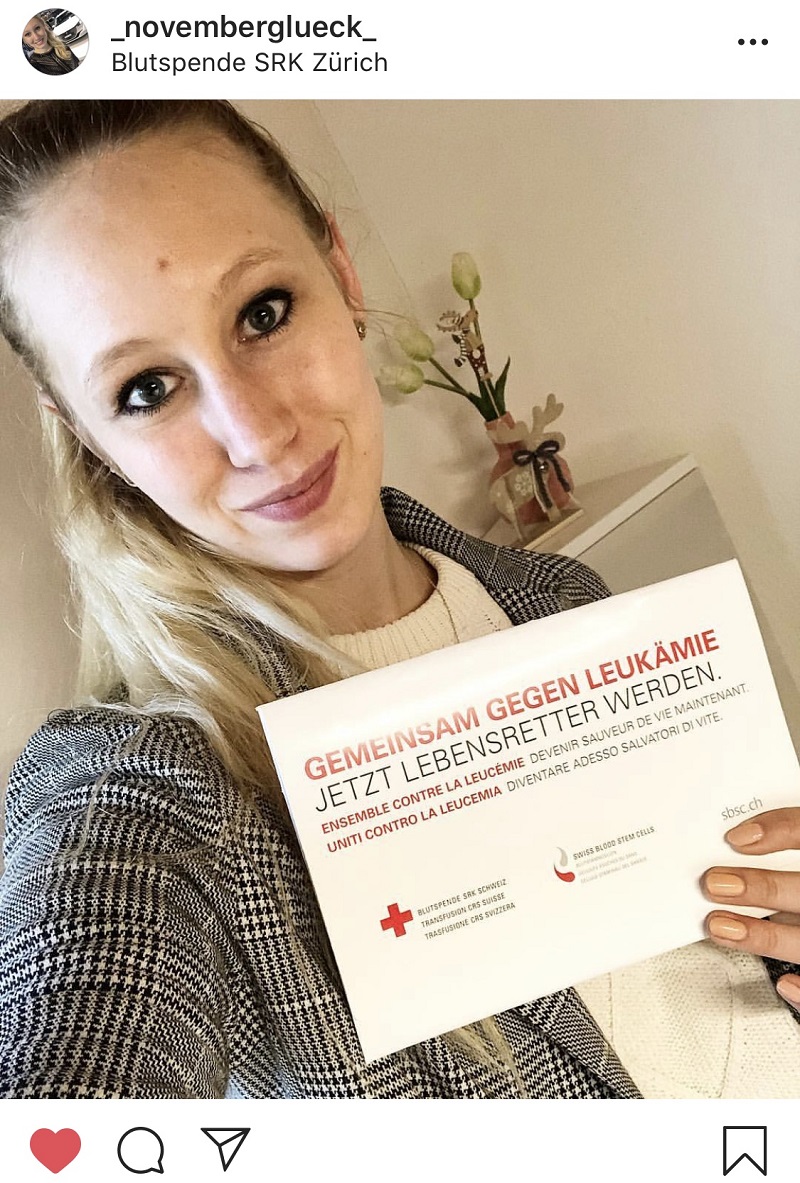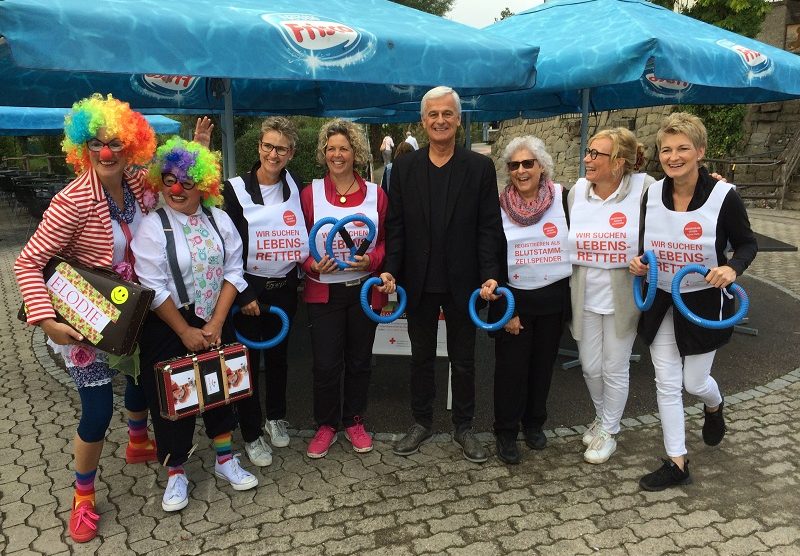In transition
The Swiss registry continued to grow, while focussing on the recruitment of younger donors. A study released in 2019 found that the Swiss registry encompasses a strikingly broad spectrum of HLA types.
Recent decades have seen great advances in the field of blood stem cell transplantation. New findings in medical research are appearing at a remarkably high pace, especially of late. For registries, this means that the ability to keep evolving is essential. A case in point: Swiss Transfusion SRC decided in 2018 to adjust its blood stem cell donor recruitment strategy with effect from 1 April 2020. 2019 was shaped by preparations for this change, in addition to routine operations.
Constant growth
At the end of 2019, the Swiss registry listed 142’900 people, a 10.4 per cent increase over 2018 (129’472 people).
A total of 14’745 people registered as blood stem cell donors, a number on a par with that for 2018 (14’566 new registrations). And 1325 persons were removed from the registry (2018: 1760), primarily due to age.

Preference for online registration
In 2019, 76.7 per cent of the people registering as donors used online forms to do so; in 2018 this percentage was only 66.3 per cent. Younger people have a particularly high affinity for online media, and they registered in larger numbers in 2019.
International research has found that people who register online are more likely to be willing to make an actual donation. Most of them have encountered the issue of blood stem cell donation several times before registering. Online registration also simplifies the administrative processes, reducing costs.
Younger, female
The percentage of registered donors who are in the under 30 age group is one of the relevant indicators for registries because the chances for a successful medical outcome are higher with transplant material from younger donors. The new recruitment strategy is therefore geared primarily towards younger age groups. Every second person (53%) who registered in 2019 was under the age of 30.
Every third person (33%) who registered in 2019 was a man. Thus, the percentages of men and women remained stable again in 2019, at 35 and 65 per cent (2018: 36 and 64). Swiss Transfusion SRC is trying to bring the ratio of men to women into balance. One of the reasons for this is that women who have given birth can form specific antibodies in their blood. Their blood stem cells can cause adverse reactions in patients, whose immune systems are very weak.

In dialogue via social media
Swiss Transfusion SRC focuses on social media channels in its efforts to raise awareness of blood stem cell donation among young people. The organisation expanded its Instagram channel in 2019, bringing the number of its subscribers up to 2095, nearly twice its 2018 total (1200). Swiss Transfusion SRC grew its Facebook following by 14 per cent to 9000 fans (2018: 7900). These are people who feel a strong attachment to the cause of blood stem cell donation. Swiss Transfusion SRC also ran social media campaigns aimed specifically at younger people for the first time in 2019. To good effect: every second person who registered was under the age of 30.
Face-to-face awareness raising
Aside from online activities, another focus lay on the many awareness raising and recruitment drives aimed at students at universities throughout Switzerland. The students from Swiss Transfusion SRC’s partner Marrow supported events, encouraging people of their own age to register.
Information was provided to the wider public on the sixth national Day of the Deed (“Tag der Tat”), which was held on 21 September, coinciding with World Marrow Donor Day. On that day, 300 volunteers provided information at stands set up for the event and the topic was picked up by regional media. Over 1100 people used their WhatsApp contact lists to draw attention to blood stem cell donation, reaching many times that number of other people.

Increasing the quality of tissue typing
When someone registers as a blood stem cell donor, tissue typing is performed to identify that person’s HLA types. As of 1 April 2020, Swiss Transfusion SRC will include the determination of current CMV status, a non-HLA parameter, in its tissue typing regime.
CMV, short for cytomegalovirus, is a virus in the herpesvirus family that is widespread throughout the world. CMV status is an important criterion considered by transplanting doctors when selecting a donor. In 2019, Swiss Transfusion SRC successfully tested the technique that will be used to determine CMV status.
Saying yes to donation
The indicator “availability” refers to the percentage of registered donors who are actually willing to donate when a request comes in. Availability is recorded when a request for confirmatory typing is made. Overall availability was 62.9 per cent in 2019, i.e. slightly below the figures for the last few years (2018: 68.6% / 2017: 69.4% / 2016: 74.8% / 2015: 72.7%). Cancellations due to personal reasons – this might be travel abroad, for instance, or the desire to have children – increased from 14 per cent in 2018 to 16.6 per cent in 2019. Cancellations for medical reasons rose from 17.4 to 20.5 per cent.
Swiss Transfusion SRC is testing measures aimed at raising availability. Among other things, starting in 2020, it will intensify and individualise communication with people already in the registry with the goal of keeping them strongly committed to blood stem cell donation, even over the course of many years.
Systematic follow-up
Swiss Transfusion SRC is responsible for the follow-up programme for all related and unrelated donors in Switzerland after their donations on the basis of a mandate from the Federal Office of Public Health. The only register in the world performing systematic follow-up of this kind encompassing related donors as well, Swiss Transfusion SRC is gathering detailed information that may be of benefit to future donors.
In the past ten years, between 80 and 90 per cent of blood stem cell donors have opted to take part in the follow-up programme, which is voluntary; in 2019, 83 per cent (return as of 20 February 2020) decided to do so. The follow-up procedure runs for ten years. Over 90 per cent of those who began the follow up programme in 2008/2009 continued with it all the way through to the end.
Return rate, per cent
Number of questionnaires mailed (related and unrelated)
Number of questionnaires received (related and unrelated)
Cord blood
At the end of 2019, the public cord blood banks in Basel and Geneva held 4911 units of cord blood; in 2018 they had 4771. Three units were issued from the banks in 2019. A hybrid banking pilot project was continued, and this option is expected to be available in early 2020. When it is, mothers will have the choice of hybrid banking, in addition to public or private banking. With hybrid banking, the cord blood is stored in a private bank but also made available to the public donor registries.
Great diversity of the Swiss registry
In connection with its new recruitment strategy, Swiss Transfusion SRC examined the role played internationally by a mid-sized registry like Switzerland’s. The results were published in 2019.
The study looked at cases where Swiss blood stem cell donors were ultimately selected as donors between 2014 and 2017 to determine whether an alternative donor was available elsewhere in the world: it found that there was not in more than 70 per cent of the cases.
In addition to the high quality of its HLA typing and the young age of donors in the registry, the great diversity of HLA types played a decisive role in this respect. The Swiss registry contains a very broad spectrum of types, a fact which can be traced back to mass migrations that took place centuries ago.
More about the study »
